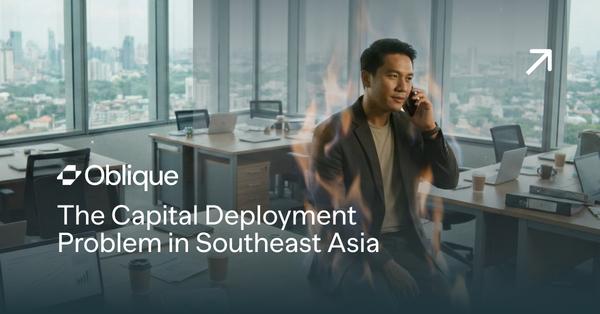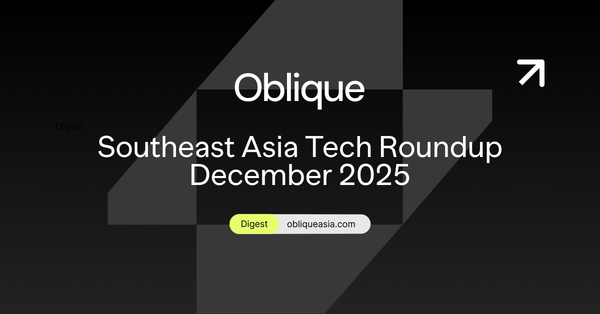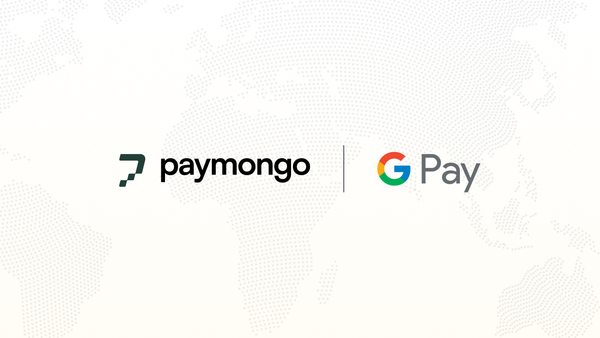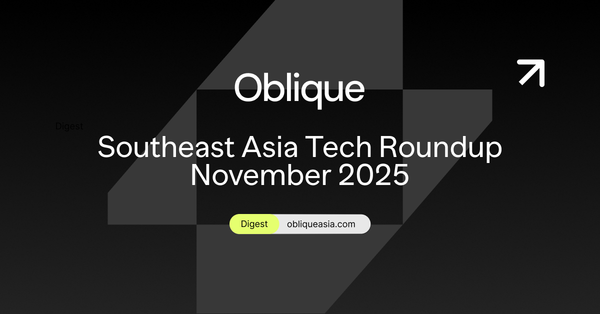Scarcity Is a Feature, Not a Flaw
Scarcity doesn’t hold Southeast Asian founders back—it sharpens their edge. In Manila’s pressure cooker, ambition thrives where patient capital is rare, challenging Silicon Valley’s playbook with hard-won resilience.

Singapore captured 92% of Southeast Asia's startup funding in the first half of 2025—$1.7 billion flowing into one city-state while the Philippines scraped together $86 million. The conventional reading: Manila is losing. The contrarian take: Manila's founders are being forged in a pressure cooker that Singapore's well-resourced ecosystem can no longer replicate.
The efficiency trap isn't a metaphor. It's a measurable phenomenon playing out across Southeast Asia's startup landscape in real time.
The Efficiency Trap
Singapore's startup machine is world-class by design. The government deployed $18.9 billion into R&D between 2021-2025, operates regulatory sandboxes, issues digital banking licenses, and maintains the infrastructure that makes "doing business" feel frictionless. Tech spending alone hit $25.5 billion in 2025, and the city-state ranked 4th globally in startup ecosystem rankings.
But efficiency has a dark side. When resources are abundant, risk calculus changes. Founders optimize instead of improvise. They wait for the right accelerator cohort, the perfect product-market fit deck, the validated business model. Causal reasoning dominates—start with the goal, reverse-engineer the path, minimize downside.
The result: Singapore produces unicorns, but too many of its founders play it safe. They're solving problems that already have venture-backable templates, building for markets that already have proven exit paths.
Meanwhile, 1,280 kilometers south, Filipino founders operate under fundamentally different constraints. This is the data: H1 2025 marked the weakest funding period for Southeast Asia in years, yet Manila jumped 20+ positions in the Global Startup Ecosystem Rankings to land in the 61-70 bracket, generating $6.3 billion in ecosystem value with a 35% CAGR. While Singapore's funding dominance creates dependence, Manila's scarcity creates discipline.
The U-Curve of Necessity
Plot entrepreneurial activity against resource availability and you get a U-curve. On one end: Silicon Valley and Singapore, where capital abundance and safety nets encourage big swings. On the other end: emerging Southeast Asian markets, where entrepreneurship isn't aspiration—it's survival.
This isn't theory. Research from Stanford and IZA distinguishes "opportunity entrepreneurship" (pro-cyclical, growth-oriented, resource-enabled) from "necessity entrepreneurship" (counter-cyclical, survival-driven, resource-constrained). The paradox: both ends produce outlier founders. The middle—just safe enough to avoid risk, just unstable enough to fear failure—is where ecosystems stagnate.
The Philippines sits firmly on the necessity end. The country's digital economy is projected to reach $80-150 billion by 2030, up from $24-35 billion in 2025, growing at 15-20% annually—the fastest clip in Southeast Asia alongside Vietnam. But this growth isn't venture-fueled. It's bootstrapped, diaspora-funded, and community-driven.
Consider the numbers: 1,200+ startups, 55 venture capital firms, and 65 incubators operate in the Philippines, yet the ecosystem raised only $1.12 billion in all of 2024. That's less than what Singapore attracts in a single quarter. The math doesn't work—unless necessity becomes methodology.
The Compound Spirit: Culture as Competitive Advantage
Filipino founders don't just survive scarcity. They weaponize it through malasakit—a cultural concept that translates imperfectly as "care" but operationally means "radical accountability to community". It's not corporate social responsibility theater. It's a founding strategy.
When government and private sector deliver little, founders self-organize. UXPH (User Experience Philippines), a 100% volunteer-run non-profit, built a 9,000-member design community through ground-up roadshows—hitting schools one by one, not just running conferences straight up in business districts. Their meetups are human, authentic, and run circles around Singapore's KPI-driven programming in terms of intentionality and content-market fit.
Reactor School, a startup school for founders under 30 across Asia Pacific, teaches what traditional business schools ignore: effectual reasoning over causal reasoning. Causal logic says "1+1=2"—define the goal, gather resources, execute. Effectual logic says "blank+blank=1"—start with available means, embrace uncertainty, co-create with stakeholders.
This distinction matters. A study on Chinese student entrepreneurs found that resource-poor founders default to effectuation because they lack the capital to run causal analyses. Filipino founders don't have a choice. They must build with what they have, who they know, and the problems they can't avoid.
The framework Reactor School uses—intent, belief, adoption, impact—mirrors this reality. Don't wait for perfect conditions. Build belief first. Adoption follows. Impact is earned, not declared.
Hidden Undercurrents
1. The Necessity Gap Isn't Just Funding
In the Philippines, entrepreneurship is often a luxury—not a pathway out of poverty. When survival is the baseline, the idea of “taking a shot” becomes economically irrational. This is where community-driven programs have real leverage: UXPH roadshows, Kickstart Ventures’ early-stage deployment (₱2.15B since 2012), and grassroots mentoring don’t just transfer skills. They shift the risk equation. They give people agency.
The data points to an overlooked truth: Filipino families already mobilize capital at scale. 12.7% of OFW households allocated remittances toward home purchases in Q4 2024—nearly double Q3’s 6.7%. Remittances hit $38.34B in 2024 and are projected to reach $41–56B by 2030. That’s not simply consumption—it’s investable capital disguised as necessity.
Yet the financial system still treats diaspora wealth as a remittance market, not a venture market. Apps like GCash are scaling international inflows—but those pesos rarely become startup equity. The opportunity is clear: reframe diaspora capital from survival support into strategic investment fuel.
2. The Outsourcing Trap Is an Economic Time Bomb
The Philippines is celebrated as the "BPO capital of the world," but this brand is economically toxic for startups. Talent gets commoditized. Salaries race to the bottom. AI automation looms. And the narrative—"Southeast Asia is the back office"—becomes self-fulfilling.
The counter-narrative is harder to scale but essential: Southeast Asia is not the outsource; it's the source. Filipino talent has global networks, cross-cultural fluency, and problem-solving instincts honed by necessity. The diaspora isn't just a remittance pipeline—it's a bridge between global tech frontiers and local ecosystems.
Returning Filipino technologists—the "Balik" movement—bring capital, expertise, and best practices back home. But this advantage only compounds if local startups can absorb and scale it. Right now, infrastructure gaps, regulatory friction, and capital scarcity limit the feedback loop.
3. The Exit Mirage Perpetuates the "Can't Build Big" Myth
Manila didn’t tumble out of Southeast Asia’s top startup cities because Filipinos lack ambition. In reality, Manila held a top-five spot through 2024 and slipped just one place to #6 in 2025—hardly a collapse, yet quick fodder for critics who claim the missing big exits prove that “Filipinos can’t build big”.
This narrative is both simplistic and misleading: the data shows a different story. Coins.ph delivered a major exit with its acquisition by Gojek, Zap continued to show sustained traction, and PDAX alongside Sprout Solutions have raised significant growth rounds. Meanwhile, Mynt (GCash) and Voyager Innovations (PayMaya) became unicorns in 2021 and 2022, respectively. These are substantial, not anomalous, achievements—made in an ecosystem where patient capital is rare, infrastructure outside Metro Manila continues to lag, and investors still expect Silicon Valley velocity from a market with fundamentally different constraints. As Joan Yao of Kickstart Ventures put it, success stories like Coins.ph prove that the Philippines can grow billion-dollar companies; when such proof appears, doors open for greater investment.
The real bottleneck isn’t ambition—it’s the length of the time horizon. Kickstart backed Coins.ph in 2016 and waited eight years for the exit; Zap took even longer. Venture capital in 2025 disproportionately rewards rapid returns, making it harder for emerging markets—perpetually asked to prove themselves each quarter—to realize their full potential.
Rewriting the Playbook
Forget the Silicon Valley script. Forget waiting for infrastructure to "catch up." Southeast Asia's unfair advantage will always be its ability to find opportunity in adversity—but only if the ecosystem stops apologizing for it.
For founders: Stop optimizing for the next funding round. Build for the necessity gap. Scarcity is your moat. The problems you solve under constraint are harder to replicate in abundance.
For educators: Teach effectual reasoning, not just causal planning. Make entrepreneurial thinking mandatory—even if 90% of students end up in jobs, the cognitive shift matters. Reactor School and UXPH prove this works at scale.
For investors: Unlock patience. The best Filipino startups won't hit profitability in 18 months. They're building in markets where payment rails are unreliable, internet penetration is uneven, and trust is earned city by city, not country by country. If you can't stomach that timeline, you're funding the wrong geography.
For policymakers: Resist the urge to "Singaporify" the ecosystem. The Philippines doesn't need more pitch competitions or co-working spaces. It needs simplified business registration (currently a bureaucratic nightmare), regulatory clarity for fintech and crypto, and incentives for diaspora capital to flow into equity, not just real estate.
For Singapore: Stop playing kingmaker. The region doesn't need another innovation hub—it needs interconnected ecosystems. Your $18.9 billion R&D budget and 5.6% tech spending growth are impressive, but your real legacy will be whether you helped lift sibling cities or just consolidated dominance.
Hope as Hard Currency
There's no neat resolution here. The funding gap won't close in 2026. Manila won't suddenly produce five unicorns. Infrastructure in Visayas and Mindanao won't magically improve.
But something else is happening. A generation of Filipino founders is learning to build without permission, to scale without safety nets, to compete not by copying the playbook but by rewriting it entirely. They're not waiting for exits to validate their ambition. They're not waiting for investors to believe in their market. They're not waiting, period.
As one founder put it in the podcast that inspired this piece: "Hope is the currency of humanity". In an ecosystem where capital is scarce, infrastructure is broken, and global narratives work against you, hope isn't soft. It's strategic. It's the belief that the future can be shaped by action, not handed down by incumbents.
The promise of Southeast Asia's startup ecosystem isn't in erasing the gap between abundance and scarcity. It's in leveraging both. Singapore's efficiency and Filipino resilience aren't mutually exclusive—they're complementary, if the region stops treating one as the model and the other as the project.
Until then, scarcity remains the Philippines' sharpest edge. And for founders willing to wield it, that edge cuts deep.





